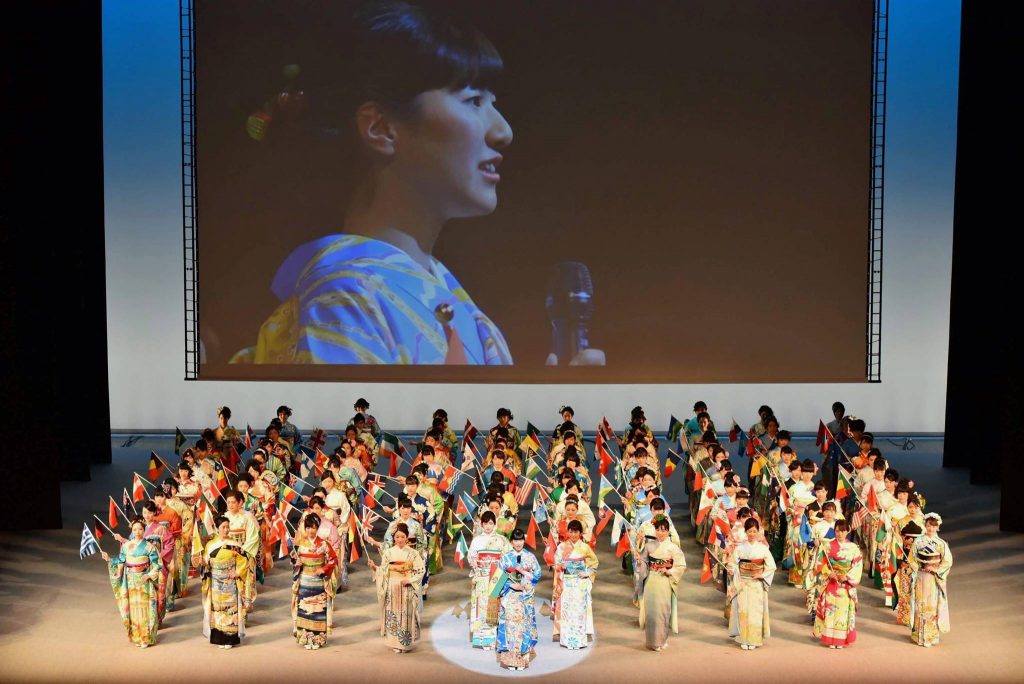
- ARAB NEWS
- 18 Apr 2024

Diana Farah
DUBAI: Japanese international organization Imagine Oneworld started the Kimono Project in 2017, with the aim to create a unique kimono pattern for every country on Earth.
Each kimono was designed and produced with the cooperation of each respective country’s embassy. The final product is meant to reflect on the country’s unique culture, history as well as its natural and architectural beauty.
Imagine Oneworld was hoping the kimonos would be incorporated in the Tokyo Olympics opening ceremony, however that did not pan out.
Four years since the project began, there are now 206 kimono designs, with a number of them designed for Arab countries.
Here are some of the designs:
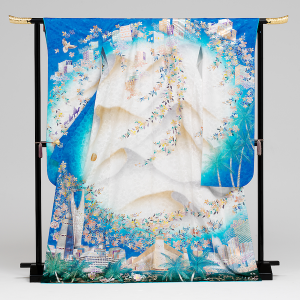
This kimono was created by Masao Wada, with the intention to depict the various buildings, flowers, palm trees, and deserts in Saudi Arabia. There is a rose pattern on the fabric, and with the advice of the Saudi Arabian embassy in Japan, the kimono adopted a bright blue background. 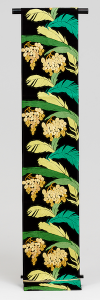
The Saudi Arabian Obi’s creator is Saito-Orimono and supervised by Hakusen. It is a work that weaves a date palm pattern. The weaving structure, which looks like embroidery, is one of the few techniques from Kyoto’s Nishijin, and the three-dimensional effect that makes it stand out gives the work “dignity and nobility.”
2. United Arab Emirates
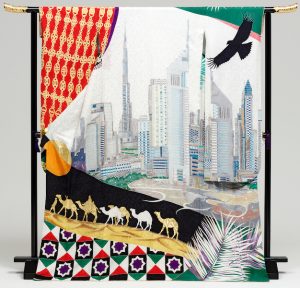
The creators of this piece were Yudai Morikawa. The kimono depicts the UAE along with Dubai’s skyline. Palm trees, falcons flying, camels with intricate silhouettes and ornaments are also featured to match the national flag. 
The Obi was created by Hattori textile. It uses Middle Eastern weaving techniques featuring gold leaves.
3. Sultanate of Oman 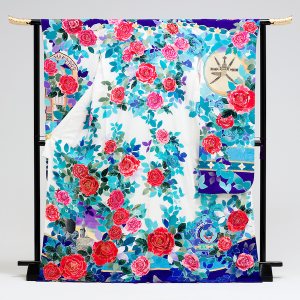
This kimono’s creator is Manabe Sachi, who designed a beautiful mosque with a glimpse of the country’s iconic Sultan Qaboos roses. Following Omani tradition, the dagger or khanjar is also depicted on the cloth. The symmetric decorative pattern of Islamic architecture is also expressed in gold leaf.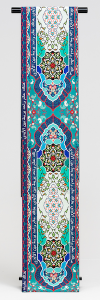
Created by Chikuzen Orimono textiles, the Omani Obi is based on the geometric pattern found in the Grand Mosque, weaving black and gold threads, with the colors of the national flag in the center.
4. Kuwait
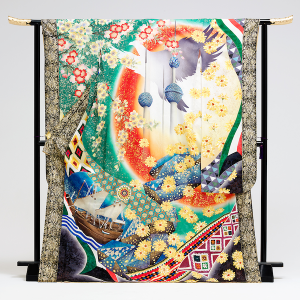
Yasuo Kabuki created the Kuwaiti kimono using gold processing called “Holo Glitter” for the Kuwait Towers. Swarovski crystals were also used for national emblems. The work uses all the techniques, such as wireless Yuzen, hand-painted Yuzen, and airbrush.
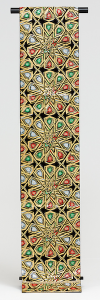
This Kuwaiti-themed Obi was produced by Tatsumura Art textile and focuses its design on the interior of the Grand Mosque in Kuwait’s capital, this work was reconstructed using the colors of the national flag.
5. Kingdom of Bahrain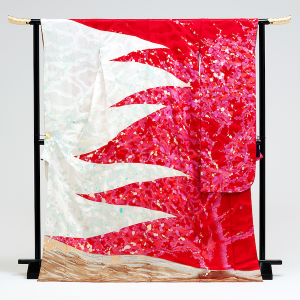
Created by Yumi Shigeta, the appearance of the kimono is studded with pearly tones, showing off the Bahraini flag in an intricate manner.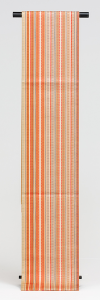
The Bahraini Obi, done by Kumiko Aizawa, uses the red and white colors of the national flag, as well as the blue associated with the country’s name, the long history and culture.
6. Qatar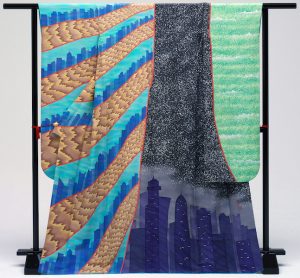
The Qatari kimono was created by Hongo Aoi Rainbow. From the front, a desert and modern skyscrapers are present. The night is depicted in the back with a starry sky and the Arabian Sea.
The Obi, done by the same creator as the kimono, shows flower crests woven into it. For the lining, green is used in the image of the Arabian Sea, as part of the depiction of a Qatari night.
7. Republic of Yemen 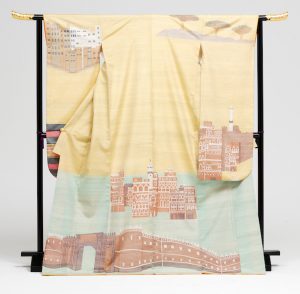
The Yemeni kimono was designed by Hisako Ichimura. Yemen’s UNESCO world heritage site Zabid is depicted on the cloth along with the castle on the rocks, the old town of Sana’a and traditional Yemeni women’s clothing in sand yellow and light green. The stained glass pattern found in traditional Yemeni architecture is also featured on the piece.
The Yemeni Obi, created by Yoko Koga, uses a color scheme based on the country’s flag. By using gold and white threads for the pattern, the designer’s skill is shown the complicated design composition of the piece.
8. Republic of Iraq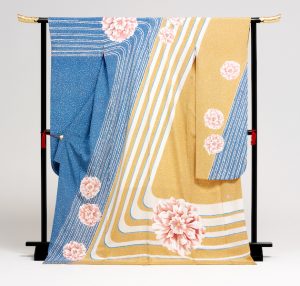
The kimono’s creator is Osamu Sakai. The two rivers of Tigris Euphrates are represented with a blue sky and beige sands uniquely curved on the piece. Roses are scattered on the kimono as they are the national flower of Iraq.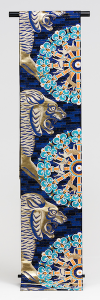
Kawashima Selkon Textiles created the Iraqi Obi, mainly focusing on the ancient Babylon ruins, which is registered as a World Heritage Site. Among them, also depicted is the Ishtar Gate that was built by King Nebuchadnezzar II in the 6th century B.C. during the ancient Babylonian period.
9. Hashemite Kingdom of Jordan
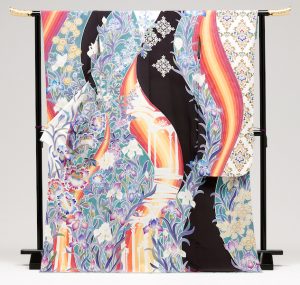
Created by Shigeharu Ueda, the Jordanian kimono uses the colors black, white, red, and green, which belong to the national flag. The staggered pattern that rises from the hem is reminiscent of the traditional Japanese pattern of “Tachiyu,” and the wish that Jordan will reflect for a long time is also included. The silhouettes of the national flowers “Black Iris”, “Peony Arabesque”, “Middle Eastern Chinese” and “Petra Ruins” are also added as wonderful accents.
Shiko Co. created the Obi, depicting the ruins of Petra and the flowers of the Black Iris woven in colors of gold and silver to further emphasize the elegance of Jordan.
10. Lebanon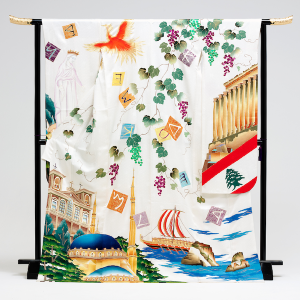
The kimono for Lebanon is designed by Dyeing Ichikawa. Churches and mosques are lined up with each other on the piece. A Phoenician ship crossing the sea as well as the Phoenician alphabet is represented. It depicts the golden phoenix, a symbol of history that has been devastated and reconstructed in numerous wars.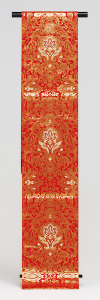
Hattori textile created a Lebanese Obi based on the theme of folk costumes and belly dance costumes. Using 6000 warp threads, it has a supple texture unique to Orimoto.
11. Palestine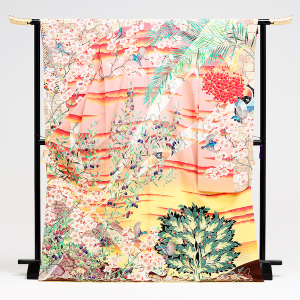
Created by Tetsuya Homma, the Palestine-themed kimono shows an arched gate made of light brown masonry, well known as the Jerusalem stone. The green fields of the West Bank, the Jordan River and the coastal blue scenery of the Gaza Strip are all woven into the piece. Most notably, the olive branches, palm fruits, almond flowers and sunbirds are also found on the kimono. The intention was to show the West Bank and the Gaza Strip, two divided areas, fit on the kimono as one country. 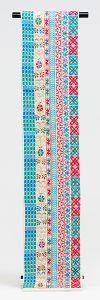
The Palestine Embroidery Obi Project created a traditional Palestinian patterned Obi, a technique usually performed by women in Palestinian homes. The embroidery is also known as ‘tatreez,’ and each pattern belongs to a specific region of Palestine.
12. Syrian Arab Republic 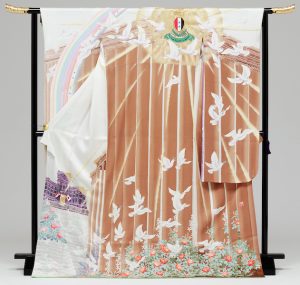
This kimono is designed by Sakai Norihito, with stone pillars placed throughout the piece depicting the Palmyra Site, which is a World Heritage Site. The coat of arms of Syria shines on the shoulders of the kimono. Damask rose, the national flower of Syria, and olive and jasmine flowers are also placed on the hem.
The Syrian Obi created by Obihiro Co., Ltd. has the motif of parquet that originated in ancient Syria.
13. Egypt 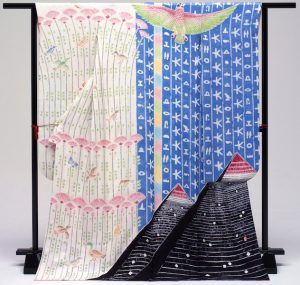
Designed by Hirotoshi Fukumura, the Egypt-themed kimono depicts birds, hieroglyphs, pyramids, the god Horus, and vertical lines on the papyrus meadows. The rich blessings of the Nile River are represented by rainbow colors, and the pyramids incorporate the national colors of Egypt. 
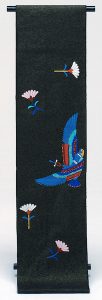
The two Obis are created by Ishikawa Tsuzure. It is a work that weaves depictions of Horus, using the nail scraping technique.
14. People’s Democratic Republic of Algeria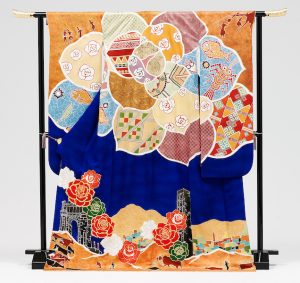
Designed by Fujiri-Kogei, the kimono has a hem composed of many world heritage sites such as the mural paintings of Tassili n’Ajjer and the archaeological site of Djemila. It depicts the long history of Algeria. In addition to the national flower roses drawn in three colors, the large roses on the back show the weight of history by referring to the mosaic paintings of the Roman ruins left in various places.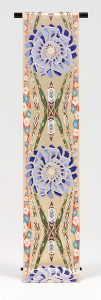
Roses are again a theme on this Algerian Obi, created by Obihiro Co., Ltd. Focusing on the ceiling painting of the palace, the pattern through the national flower roses is woven luxuriously using gold leaf and colorful threads.
15. Republic of Tunisia 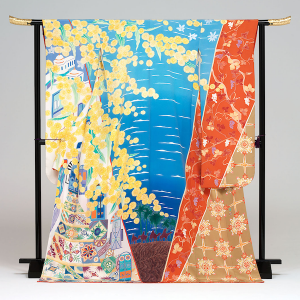
This kimono is designed by Kozo Shirasaka and expresses the rich nature of Tunisia with diverse climates and landscapes. Drawn on are features of the desert tea, salt lake red, Mediterranean blue, and pure white cityscape, animal silhouettes, grape arabesque, and patterns left by indigenous people. The national flower Fusa acacia decorates the whole kimono.
The Tunisian Obi, designed by Watabun Co., Ltd., focuses on the blue of Islamic art, and is composed of mural paintings of ancient ruins.
16. Kingdom of Morocco 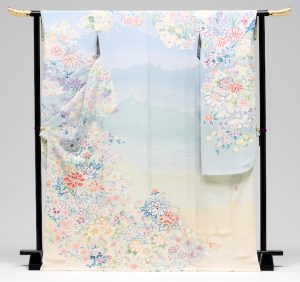
The Moroccan kimono is designed by Kotaro Omura, who visited Morocco, imprinted the scenery he saw with his skill. The journey from the Sahara Desert to the Atlas Mountains to the Mediterranean Sea is depicted as a silhouette of each, and the people the designer met are depicted as being wrapped in various flowers. 
Hattori Orimono Co., Ltd. created the Obi, weaving Moroccan arabesque patterns with the ultimate pulling technique of stacking three pieces of gold leaf. A work that highlights the beauty of Arabian art.
17. Republic of Sudan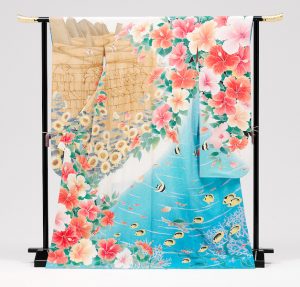
Created by Yoneshige Kamimura, the ruins of the ancient city of Nubia, the pyramids of Meroe in the Kingdom of Kush, the national flower hibiscus and the sunflower, the beautiful Red Sea in the National Marine Park of World Natural Heritage and its fish are depicted. The white part between the desert and the sea is drawn as “White Nile”, meaning the Nile River, expressing the great nature and the eternal history.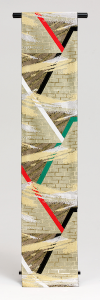
Kawashima Selkon Textiles Co.,Ltd produced this Obi, showing shapes of pyramid and incorporating the color of the national flag. The wind patterns of the sand, wind and the masonry of the pyramid are woven by gold.